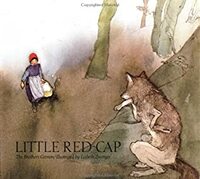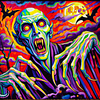You need to sign in or sign up before continuing.
Take a photo of a barcode or cover
3.5
This is not my favourite story from the Grimm Fairy Tales but it is a good little tale. There was definitely a little more to the story than I thought and that was surprising in a good way.
This is not my favourite story from the Grimm Fairy Tales but it is a good little tale. There was definitely a little more to the story than I thought and that was surprising in a good way.
adventurous
dark
hopeful
mysterious
tense
fast-paced
Plot or Character Driven:
Plot
Strong character development:
No
Loveable characters:
No
Diverse cast of characters:
No
Flaws of characters a main focus:
N/A
The Grimm Brothers’ “Little Red Cap” (Rotkäppchen in German), commonly known as “Little Red Riding Hood”, is one of the most well-known fairy tales in the world. Below is an overview of its origins, history, and interesting details.
Origins and History
Origins and History
1. Folkloric Roots:
The tale of Little Red Riding Hood predates the Brothers Grimm, with oral versions of the story circulating across Europe for centuries. It has deep roots in folk traditions, particularly in rural areas, where it often served as a cautionary tale for children.
2. Earliest Written Versions:
• The earliest recorded version of the story comes from Charles Perrault in his 1697 collection Histoires ou Contes du Temps Passé (Tales of Times Past). Perrault’s version (Le Petit Chaperon Rouge) included a moral warning, as his stories were intended for the aristocracy. In this version, the girl is eaten by the wolf, and there is no happy ending.
• The Grimms’ version, first published in 1812, was adapted from oral sources, particularly from the stories told by their friends and collaborators, like Dorothea Viehmann. The Grimms softened the story slightly to make it more palatable for families while retaining its dark undertones.
3. Grimm Adaptation:
The Grimms added a second part to the tale, where the grandmother and Little Red Cap are saved by a passing huntsman. They also revised and polished the story in subsequent editions, giving the heroine and her grandmother a triumphant ending.
Symbolism and Themes
1. Coming of Age:
• The red hood or cap is often interpreted as a symbol of puberty, maturity, or sexual awakening. The story explores the transition from innocence to awareness.
2. Stranger Danger:
• At its core, the tale is a warning against trusting strangers, represented by the cunning wolf.
3. Nature and Civilization:
• The forest represents danger and the unknown, contrasting with the safety of the path and the grandmother’s home.
Interesting Facts
1. Wolf as a Predator Archetype:
The wolf in Little Red Cap is an archetype of a predatory figure, sometimes representing literal threats (such as dangerous animals) or metaphorical ones (like deceptive men).
2. Regional Variations:
• Italian versions (e.g., La Finta Nonna, or “The False Grandmother”) often include the girl outsmarting the wolf, showing her resourcefulness.
• In some oral versions from France and Italy, Little Red Riding Hood escapes by her own cleverness, such as claiming she needs to relieve herself and running away.
3. Adaptation to Morality:
• The Grimms’ version emphasizes consequences but also introduces a savior figure (the huntsman), teaching the values of bravery and community support.
• Perrault’s tale was darker, with no rescue, teaching a stricter moral lesson to heed parental warnings.
4. Evolution Over Time:
The story has shifted from a dark and often violent folk tale to a family-friendly narrative through retellings and adaptations. The addition of the huntsman in the Grimms’ version is one of the most notable changes.
5. Modern Interpretations:
• The story has inspired countless adaptations in literature, film, and other media, often exploring its darker themes or flipping the narrative. Examples include Into the Woods, The Company of Wolves (1984), and Neil Gaiman’s The Wolves in the Walls.
• Little Red Riding Hood has been analyzed from feminist perspectives, interpreting the tale as a warning against predatory men or a story of female empowerment.
Cultural Impact
• Little Red Cap remains a cultural touchstone, serving as a framework for storytelling in many genres. Its iconic imagery—red hood, dark forest, hungry wolf—has been reimagined countless times in art, advertising, and popular culture.
• The tale’s ability to convey complex themes through simple storytelling ensures its enduring popularity.
Just a perfect story to tell your children how gullible people are liable to manipulation. It is one of those stories that can be interpenetrated in so many ways and also feeling happy for having finally read a Grimm fairy tale with out an evil step mother in it.
dark
reflective
fast-paced
Haunting illustrations but, frankly, not a child friendly story when you really think about it.
After everything
“The grandmother ate the cake and drank the wine that Little Red Cap had brought”
“The grandmother ate the cake and drank the wine that Little Red Cap had brought”





